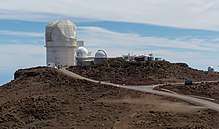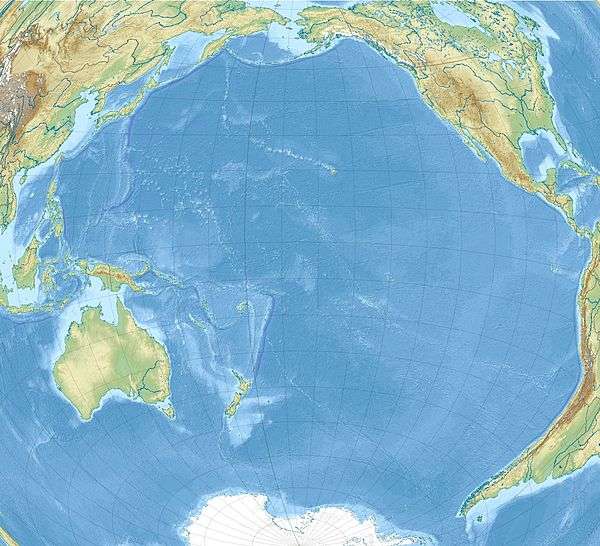Daniel K. Inouye Solar Telescope
The Daniel K. Inouye Solar Telescope (DKIST) is a scientific facility for studies of the sun at Haleakala Observatory on the Hawaiian island of Maui. Known as the Advanced Technology Solar Telescope (ATST) until 2013, it was named after Daniel K. Inouye, a US Senator for Hawaii.[1] It is the world's largest solar telescope, with a 4-meter aperture.[2][3] The DKIST is funded by National Science Foundation and managed by the National Solar Observatory. It is a collaboration of numerous research institutions. Test images were released in January 2020; routine science observations are slated to commence in July 2020 after construction is complete.[4]
 Daniel K. Inouye Solar Telescope on the left hand side | |
| Alternative names | DKIST |
|---|---|
| Named after | Daniel Inouye |
| Part of | Haleakalā Observatory |
| Location(s) | Haleakalā Observatory, Haleakalā, Maui County, Hawaii |
| Coordinates | 20°42′17″N 156°10′36″W |
| Organization | National Solar Observatory |
| Altitude | 3,084 m (10,118 ft) |
| Wavelength | 380 nm (790 THz)-5,000 nm (60 THz) |
| Built | January 2013 |
| First light | December 2019 |
| Telescope style | Gregorian telescope optical telescope solar telescope |
| Diameter | 4.24 m (13 ft 11 in) |
| Secondary diameter | 0.65 m (2 ft 2 in) |
| Illuminated diameter | 4 m (13 ft 1 in) |
| Collecting area | 12.5 m2 (135 sq ft) |
| Mounting | altazimuth mount |
| Website | www |
 Location of Daniel K. Inouye Solar Telescope | |
The DKIST can observe the sun in visible to near-infrared wavelengths and has a 4.24-meter primary mirror in an off-axis Gregorian configuration that provides a 4-meter clear, unobstructed aperture. Adaptive optics correct for atmospheric distortions and blurring of the solar image, which enables high-resolution observations of features on the sun as small as 20 km (12 mi). The off-axis, clear aperture design avoids a central obstruction, minimizing scattered light. It also eases operation of adaptive optics and digital image reconstruction such as speckle imaging.
The site on the Haleakalā volcano was selected for its clear daytime weather and favourable atmospheric seeing conditions.
Construction
The contract to build the telescope was awarded in 2010, with a then-planned completion date of 2017.[5] Physical construction at the DKIST site began in January 2013,[6] and work on the telescope housing was completed in September 2013.[7]
The primary mirror was delivered to the site the night of 1–2 August 2017[8] and the completed telescope provided images of the sun in unprecedented detail in December 2019. Further instruments, to measure the Sun's magnetic field, were to be added in the first half of 2020.[3]
Main telescope structure
The 75 mm thick f/2 primary mirror is 4.24 meters in diameter with the outer 12 cm masked, leaving a 4-meter off-axis section of a 12-meter diameter, f/0.67 concave parabola. It was cast from Zerodur by Schott and polished at the Richard F. Caris Mirror Laboratory of the University of Arizona and aluminized by the AMOS mirror coating facility.[9][10]
The 0.65-meter secondary mirror, a concave ellipsoid with a focal length of 1 meter, was made from silicon carbide and is mounted on a hexapod to compensate for thermal expansion and bending of the telescope structure keeping the mirror in its optimal position.
Adaptive and active optics
Instrumentation
_as_of_January_20%2C_2020.jpg)
DKIST is expected to have five first-generation instruments.[11]
Visible Broadband Imager (VBI)
The VBI is a diffraction-limited two-channel filtergraph each made of an interference filter and a digital scientific CMOS sensor camera that samples the image of the sun. Each camera features 4k×4k pixels. The interference filters work as a band-pass filter that only transmits a selected wavelength range (i.e. color) of the sunlight. Four different interference filters are available in each channel that are mounted in a motorized fast-change filter wheel.
VBI blue channel (45″ field of view)
- 393.327 nm, FWHM: 0.101 nm (Ca II K spectral line, dark-violet)
- 430.520 nm, FWHM: 0.437 nm (G-band, violet)
- 450.287 nm, FWHM: 0.41 nm (blue continuum)
- 486.139 nm, FWHM: 0.0464 nm (H-beta spectral line, turquoise)
VBI red channel (69″ field of view)
- 656.282 nm, FWHM: 0.049 nm (H-alpha spectral line, light-red)
- 668.423 nm, FWHM: 0.442 nm (red continuum)
- 705.839 nm, FWHM: 0.578 nm (Titanium(II) oxide (TiO) spectral line, dark-red)
- 789.186 nm, FWHM: 0.356 nm (Fe XI spectral line)
Per wavelength, a burst of images shall be recorded with high frame rate (30 fps), digitally analyzed and formed into a single sharpened image (speckle-reconstruction).
VBI is fabricated by the National Solar Observatory.
Visible Spectro-Polarimeter (ViSP)
ViSP is fabricated by the High Altitude Observatory.
Visible Tunable Filter (VTF)
VTF is fabricated by the Kiepenheuer-Institut für Sonnenphysik.
Diffraction-Limited Near-InfraRed Spectro-Polarimeter (DL-NIRSP)
DL-NIRSP is a diffraction grating based integral field spectrograph with a spectral resolution R=250000. DL-NIRSP is fabricated by Institute for Astronomy (IfA) of the University of Hawaii.
Cryogenic Near-InfraRed Spectro-Polarimeter (Cryo-NIRSP)
Cryo-NIRSP is fabricated by Institute for Astronomy (IfA) of the University of Hawaii.
Partners
As of 2014, twenty-two institutions had joined the collaboration building DKIST:[12]
- Corporate Office: Association of Universities for Research in Astronomy
- Funding Agency: National Science Foundation
- Principal Investigator: National Solar Observatory
- Co-Principal Investigators:
- High Altitude Observatory
- New Jersey Institute of Technology
- Institute for Astronomy, University of Hawaii
- Department of Astronomy and Astrophysics and Department of Mathematics, University of Chicago
- Collaborators:
- Air Force Research Laboratory
- Bellan Plasma Group, Laboratories of Applied Physics, California Institute of Technology
- Department of Physics and Astronomy, California State University at Northridge
- Colorado Research Associates
- Harvard-Smithsonian Center for Astrophysics
- Kiepenheuer-Institut für Sonnenphysik, Freiburg, Germany
- Lockheed Martin Solar and Astrophysics Laboratory
- Department of Physics and Astronomy, Michigan State University
- Department of Physics, Montana State University
- NASA Goddard Space Flight Center
- NASA Marshall Space Flight Center
- Plasma Physics Laboratory, Princeton University
- Instrumentation and Space Research Division, Southwest Research Institute
- W.W. Hansen Experimental Physics Laboratory, Stanford University
- University of California Los Angeles
- Center for Astrophysics and Space Sciences, University of California, San Diego
- Center for Astrophysics and Space Astronomy and Joint Institute for Laboratory Astrophysics, University of Colorado at Boulder
- Department of Physics and Astronomy, University of Rochester
References
Footnotes
- "Solar Telescope Named for Late Senator Inouye". National Solar Observatory. 16 December 2013. Retrieved 21 October 2015.
- Witze, A. (29 January 2020). "World's most powerful solar telescope is up and running". Nature. doi:10.1038/d41586-020-00224-z.
- Hannah Devlin (29 January 2020). "Telescope captures most detailed pictures yet of the sun". The Guardian.
- Crockett, C. (29 January 2020). "These are the most detailed images of the sun ever taken". Science News. Retrieved 30 January 2020.
- "NSF Selects NSO to Build World's Largest Solar Telescope" (Press release). SpaceRef. 22 January 2010. Retrieved 16 March 2017.
- "Building the DKIST – Image Gallery". dkist.nso.edu. Archived from the original on 13 September 2014. Retrieved 22 August 2015.
- Durand, Pierrot (21 September 2013), "Work on Dome Completed, say Spanish Companies", French Tribune, retrieved 26 September 2013. (Note that the illustration accompanying the article is a 2012 artist’s rendering of the Thirty Meter Telescope calotte dome, and looks nothing like the actual ATST enclosure.)
- "Primary mirror delivered to Daniel K. Inouye Solar Telescope" (Press release). National Science Foundation. 3 August 2017. News Release 17-072.
- Communications, University Relations- (11 December 2015). "UA Completes Primary Mirror for Advanced Solar Telescope". UANews. Retrieved 4 February 2020.
- "DKIST M1 Mirror Successfully Aluminized". NSO - National Solar Observatory. 4 June 2018. Retrieved 4 February 2020.
- "DKIST Instruments". NSO - National Solar Observatory. Retrieved 4 February 2020.
- "Collaborating Institutions". dkist.nso.edu. Retrieved 14 May 2014.
Sources
- Keil, S. L.; Rimmele, T. R.; Wagner, J.; The ATST team (June 2010). "Advanced Technology Solar Telescope: A status report". Astronomische Nachrichten. 331 (6): 609–614. Bibcode:2010AN....331..609K. doi:10.1002/asna.201011385.
External links
![]()